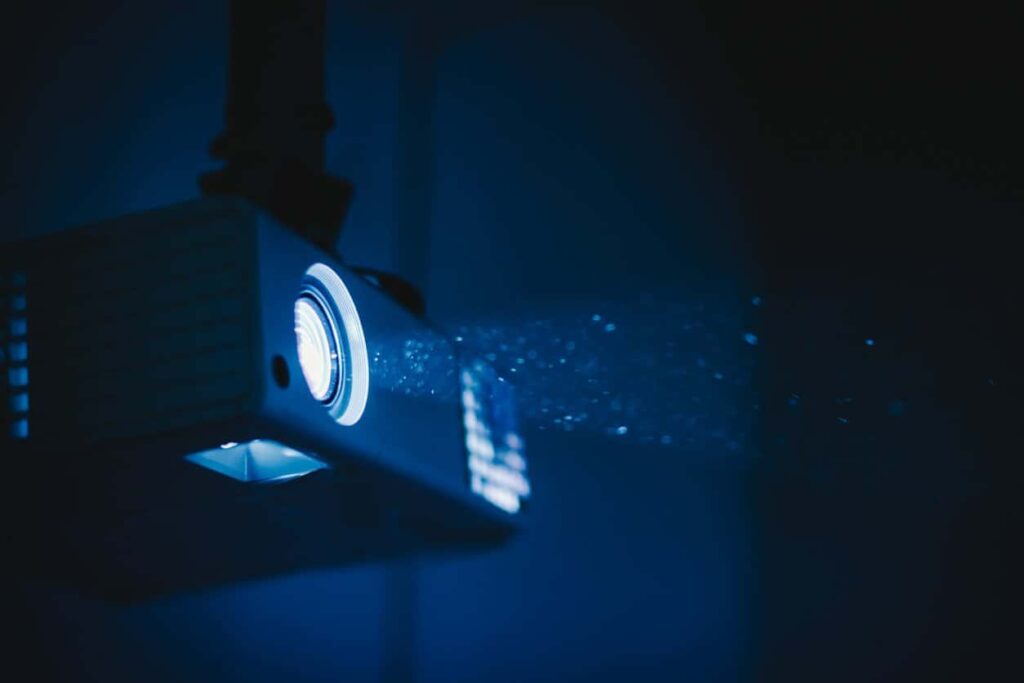why is my projector not displaying

When you’re trying to watch a movie or video using a projector, you want the picture to be really clear. But if the projector isn’t working right, you might get annoyed and wonder, Why is my projector not showing the picture correctly?
There are a lot of reasons why a projector might not be working well. Figuring out what’s wrong can be tricky if you don’t know what to look for. The first thing to do is check if there’s any damage or problems with the projector. It might be broken or not working because it hasn’t been taken care of.
In this article, we’ll talk about common projector problems and how they can affect your movie-watching. We’ll do our best to explain things clearly, even if you’re not an expert.
Why Is My Projector Not Displaying?
1. Double-check the Input Source
A common cause of projector display issues is a change in the input source when the projector was off or disconnected from power. To resolve this, go through your available input options and confirm that they match what’s displayed on your computer screen (or other device like a laptop, tablet, or smartphone).
2. Make Sure The Projector Is Receiving Power
To make sure your projector is getting power, start by verifying that it’s plugged in and turned on. You can do this by checking the indicator light on your projector.
If the light isn’t on, that means your projector is not receiving power. Next, confirm that the power cord is properly connected to a functional electrical outlet by inspecting where it’s plugged in, either in the outlet itself or at the fuse box.
3. Check The Cable Connections
Ensure Proper Cable Connections. If you’re using a VGA connection, confirm that the display resolution on your computer matches the resolution your projector supports.
Additionally, inspect the projector’s shutter and focus ring for potential issues. These components can get stuck or damaged if not handled with care.
4. Make Sure Cables Are Connected To The Computer And Projector
To ensure your monitor cable is firmly connected to both your computer and monitor, follow these steps:
- Inspect the cable to confirm it’s securely plugged into both devices, with no loose ends or damaged wires.
- Examine both ends of the cable for any broken connections. If any issues are found, consider using a different cable for testing.
5. Make Sure The Display Resolution On Your Computer or Laptop Matches With Projector
When using a VGA connection, be sure to match your computer’s display resolution with the supported resolution of your projector.
Setting the resolution too high can lead to a black screen, while setting it too low may result in a blurry image. In such cases, it might be worth thinking about upgrading your video card or purchasing a new projector.
6. Ensure Nothing Is Blocking The way Of Light From The Lens To The Projected Screen
If the projected image is not visible, ensure there are no obstructions, like a window, and confirm that the projector is not exposed to direct sunlight.
7. Check For a Damaged Shutter Or Focus Ring
Inspect the lens to ensure it is free from dust or dirt. Verify the focus ring is undamaged, as a bent screw can lead to its instability, potentially affecting its functionality.
Likewise, if your projector features an accessible shutter (the part where light enters), make sure it is not stuck in position, which could impact your image display.
Hence, there are various possible causes for your projector’s display issues, so it’s wise to conduct a physical examination rather than assuming it’s broken.
8. The bulb in your projector has burned out
When the bulb in your projector is bad, it can bring your cinematic or presentation experience to a sudden halt. The projector bulb, also known as a lamp or lamp module, is an essential component that emits the light necessary for projecting images onto the screen.
Over time, these bulbs have a limited lifespan, and their eventual burnout is a natural occurrence. Replacing the projector lamp is the solution to restore the projector’s functionality, and it’s essential to consult the user manual or seek professional assistance to ensure the new bulb is the correct type and properly installed.
9. Broken or not properly plugged in HDMI cord
This seemingly simple cable is essential for transmitting high-definition audio and video signals from one device to another. If the HDMI cord is broken or damaged, it can disrupt the connection and result in no signal or a distorted picture.
Furthermore, not securely plugging in the HDMI cable at both ends can lead to similar issues. In such cases, troubleshooting involves checking for visible damage on the cord and ensuring it’s firmly connected to both the source device and the display. Simple as it may seem, addressing HDMI cable issues is often the key to restoring seamless connectivity and enjoying your multimedia content without interruptions.
How to get the Projector show Screen
If you’re seeking guidance on screen sharing with a projector or wondering how to make your projector display the screen, here are some fundamental troubleshooting measures to consider:
1. Ensure The Source Is On And Working
To begin, ensure that your projector is connected to a power supply. The power cable should be securely inserted into an outlet or another suitable power source to guarantee proper operation.
Next, confirm that your projector is correctly linked to its respective screen using an HDMI or VGA cable.
Additionally, make certain that there is no interference from other electronic devices in your home, such as Wi-Fi routers or mobile phone chargers, as they can potentially disrupt signal transmission between devices like the ones mentioned above.
2. Check The Cables And Power
Ensure that all your cables are firmly plugged into their designated ports. Loose connections can lead to a loss of communication between the projector and screen, potentially resulting in subpar image quality on your display.
Verify that your projector is set to the correct mode. When the projector is in the correct mode, it should be straightforward to have it display the screen.
To confirm that you’ve configured your projector properly, consult your remote control to inspect the input type and make certain it’s configured to HDMI 1 or 3, depending on the connected monitor.
3. Try a Different Input Type
If your projector offers multiple input options, consider trying an alternative one. For example, if your projector has both HDMI and VGA ports, attempt connecting your device to the VGA port instead of HDMI.
Sometimes, the solution can be as straightforward as revisiting your cable connections, but it may also entail adjusting settings or switching between inputs. To ensure a proper connection, power off your projector and disconnect it from the power source.
Make certain that all cables are securely fastened to their respective ports on the rear of your monitor or screen. If your projector provides multiple input choices, cycling through them until you find one that functions correctly usually resolves most connection issues. If none of these steps prove effective, consider seeking assistance from a technician.
Conclusion
In summary, troubleshooting common projector issues doesn’t have to be a daunting task. Simple steps such as verifying your power connections, cable integrity, and input settings can often resolve most problems you might encounter when using a projector. Ensuring secure and correct cable connections can prevent signal disruptions and poor image quality, while selecting the appropriate input mode is crucial for seamless screen projection.
Moreover, if you have multiple input options, don’t hesitate to experiment with different connections or settings. The process can be systematic, and a bit of trial and error may reveal the solution to your issue. However, should these troubleshooting steps fail to rectify the problem, seeking assistance from a professional technician is always a viable option. By adhering to these troubleshooting guidelines, you can enhance your projector’s reliability and ensure a smoother projection experience.
Related Posts:
How do I know if my projector lamp is bad
How Do I Stop My Projector From Ghosting
References:


